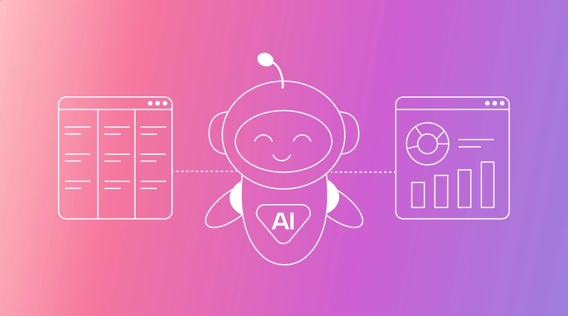As of 2023, 73% of businesses say they already used AI in some capacity. One of their major goals is leveraging it to better understand their data.
And the average enterprise has 10 petabytes (10 million GB) of data — up to 52% of which is not used in a meaningful way.
AI analytics can help you find hidden insights in the data sets you’re currently ignoring. Plus, it can revolutionize the way you analyze high-priority data about your customers and processes.
What is AI analytics?
AI analytics is when you use artificial intelligence algorithms to automate data preparation, analysis, and interpretation (including predictions). It can even prescribe beneficial next actions without any human input.
You don’t need to manually collect and parse data through spreadsheets and formulas with AI analytics. The analytics handles the data wholesale and looks for meaningful patterns outside of rigid formulas or segments.
In short, AI analytics give employees easy access to data-driven insights in various business areas.
What makes AI analytics different from traditional analytics?
AI analytics relies on different implementations and techniques than traditional analytics. Also, the scope of its use cases is often a lot broader.
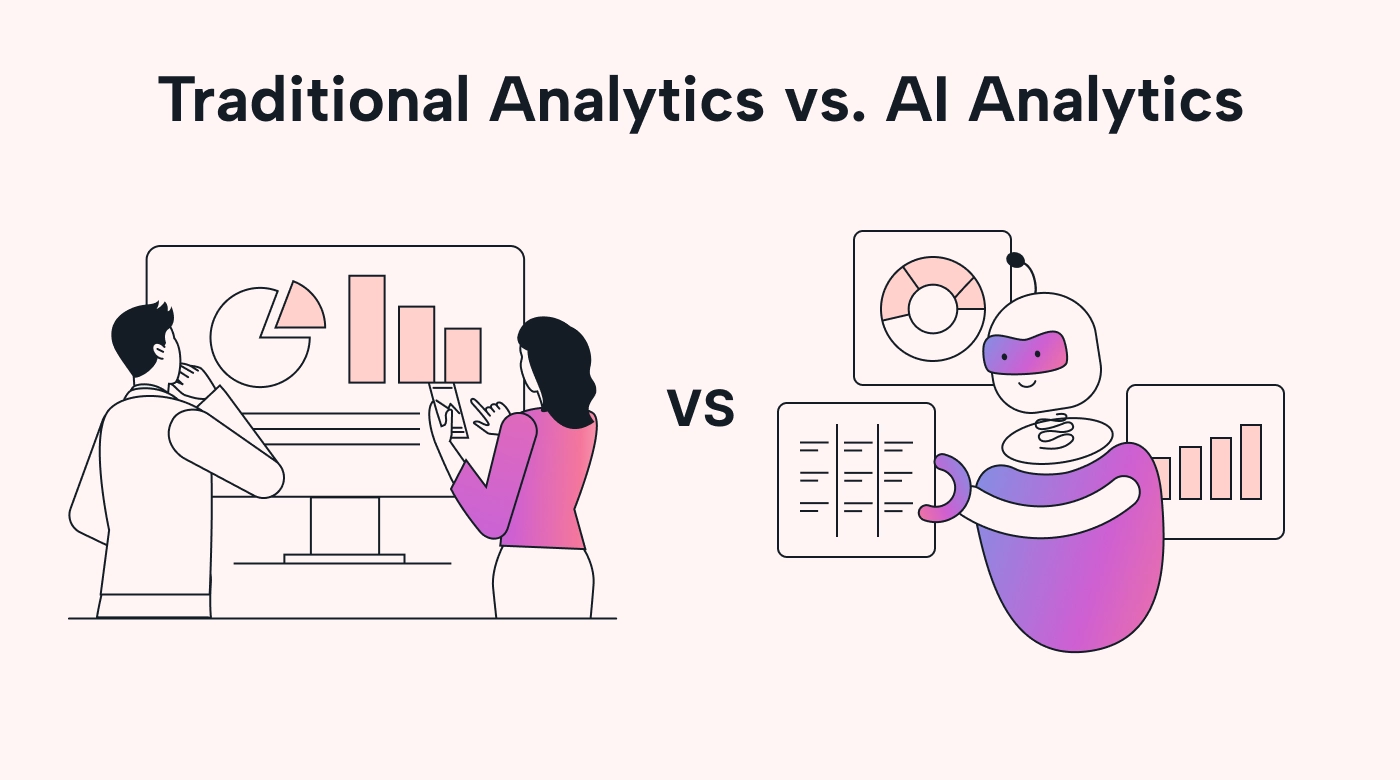 |
Let’s look at these differences in more detail.
Traditional analytics relies on rigid formulas and manual work to identify patterns
Traditional analytics relies on a lot of manual work. Analysts use formulas, statistical models, and brainstorming to find insights — an often long and challenging process.
For example, many marketers use manual audience segmentation. They single out traffic or users that have taken certain actions, helping them analyze that audience separately.
An example of this is users who come from a specific source, like YouTube videos. Here’s how you’d analyze this segment manually:
- Choose identifiers for the customer segment — the referral source.
- Compare concrete data points, like the number of visits or purchases.
- Apply basic statistical models to the segment using an analytics platform.
- Compare your results to benchmarks like other segments or all customers.
That’s how you find out if YouTube visitors are likely to be high-value customers or not.
This is in stark contrast to how the process of finding valuable insights in data works with AI. (And today, most analytics solutions offer some level of AI capabilities.)
AI analytics leverages machine learning to automatically find insights
With AI analytics, you don’t have to do manual analysis in the same step-by-step process. Instead, you leverage machine learning models that identify patterns at scale.
For example, an AI analytics platform would be able to identify various patterns of high-value customer behavior with minimal input.
Traditional analytics can deliver actionable insights, but you have to interpret them yourself. AI analytics can accurately forecast the future and even prescribe your team’s action steps.
You can divide AI analytics tools into two categories based on their main function:
- Predictive analytics: Algorithms interpret data to predict trends in sales, usage, and more. Predictive analytics can help you adapt your strategies for the long term, not just the short term.
- Prescriptive analytics: The AI suggests actions to take based on meaningful insights from the data. For example, AI-powered customer support analytics may indicate which at-risk customers you need to prioritize. In a sense, it makes smart business decisions for you.
If you’re wondering how all of this is possible, let’s explore the building blocks of AI analytics.
How AI analytics works: Machine learning, neural networks, and more
Thanks to progress across a wide variety of areas in AI, analytics has progressed immensely over the past few years. So, today, even the most “basic” AI analytics tools rely on a wide range of frameworks, models, and technologies.
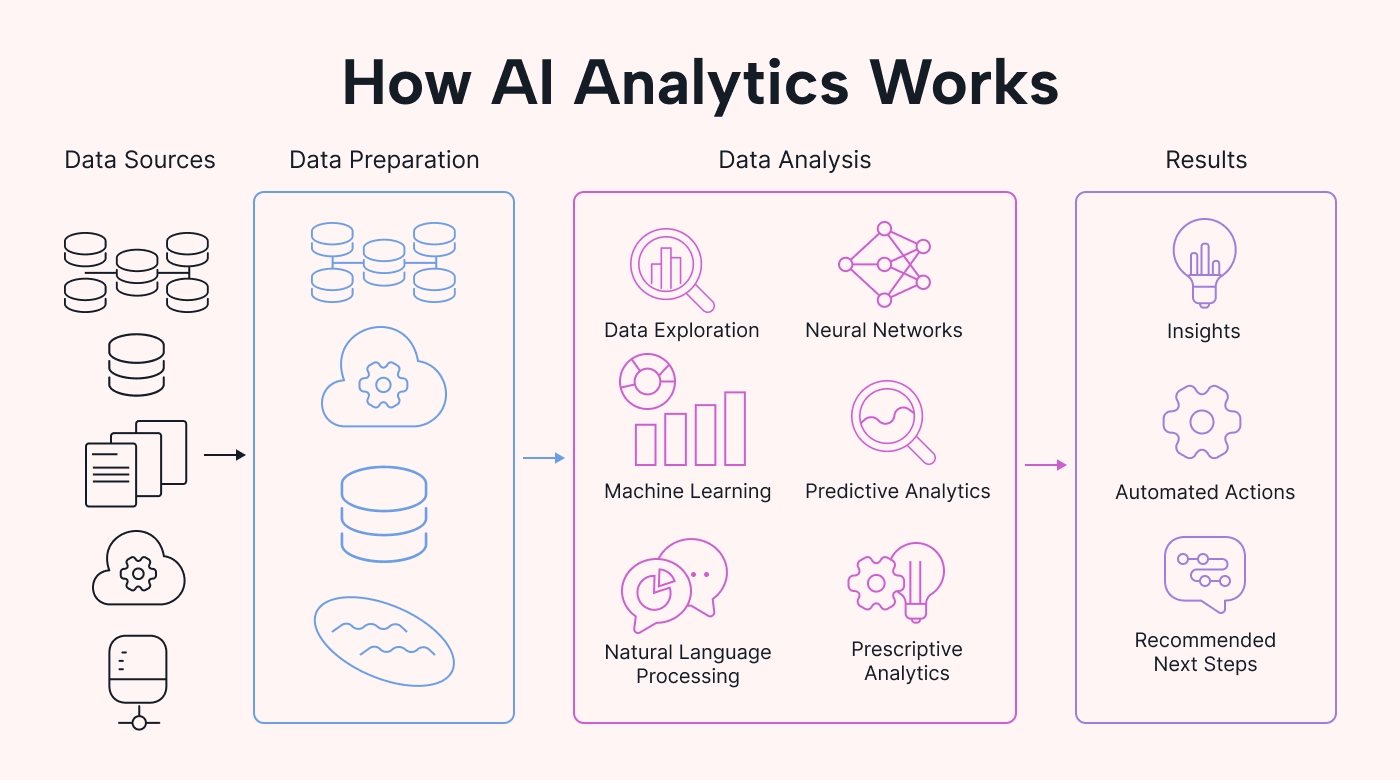 |
There’s often no need for manual data exploration by human analysts. Most analytics platforms today can do this automatically. This is called augmented analytics.
Basically, the platform handles data visualization and initial statistical analysis by itself.
Machine learning
Machine learning is the general term for AI efforts and techniques that help computers learn with minimal training.
Instead of humans prescribing the exact outcome they want through a complex formula, the algorithm learns through trial and error. In supervised learning, human input is what helps the algorithm distinguish the right answer from the wrong one.
Think of how in Google Translate, millions of users correct incorrect translations over time. The algorithm uses this feedback to gradually improve its translations across the board (not just for the corrected sentences).
While “basic” machine learning algorithms are still used for analytics purposes, most platforms today rely on more advanced AI frameworks.
Neural networks and deep learning
Neural networks are a subcategory of machine learning algorithms inspired by the way neurons organize into networks in organic brains. They’re often used to extrapolate based on limited data. This allows them to make predictions or prescriptions based on experience.
We call the process of using neural networks deep learning. This illustration from a research paper clearly shows how it’s different from regular machine learning:
With machine learning, humans have to complete the feature extraction process manually. In deep learning, however, the algorithm itself sorts the data set based on the differences it identifies. This allows deep learning algorithms to excel in areas where even humans struggle to identify differences.
For example, neural networks are used to predict cancer in MRIs or x-rays, and the ideal ad for a certain visitor.
Natural language processing
Natural language processing (NLP) models are AI models that help computers react to and answer questions in human languages. They allow people with no knowledge of coding languages to interact with the AI. So, learning Python is luckily no longer a barrier to entry.
Just think of chatbots and generative AI, where:
- You type a question in English or another language.
- The bot then responds in that same language.
You don’t need any coding knowledge to use AI to get your desired answer.
Generative AI
Generative AI is capable of generating text, images, or video based on prompts. The most famous example is ChatGPT, OpenAI’s chatbot that uses GenAI technology for its answers.
If you’re struggling to understand any of the terms we use in this article, please refer to our AI glossary.
Top business use cases for AI analytics
Let’s look at some concrete use cases that apply to most businesses. We’ll explore how AI analytics can help you maximize your resources across:
- Marketing
- Customer service
- Team productivity
- Finance operations
(If you’re in a specific industry where AI has specialized use cases, like healthcare, you probably know these already.)
Analyzing your customers and delivering better experiences to them
Most established web analytics platforms have already leveraged AI to some extent to help you better understand your audience and customers.
AI e-commerce analytics can notice changes in shopping patterns and suggest optimizations. For example, it can prescribe adjustments to your marketing strategy based on recent market trends.
But the most advanced use-case for AI-powered analytics is to deliver a custom experience to users in real time.
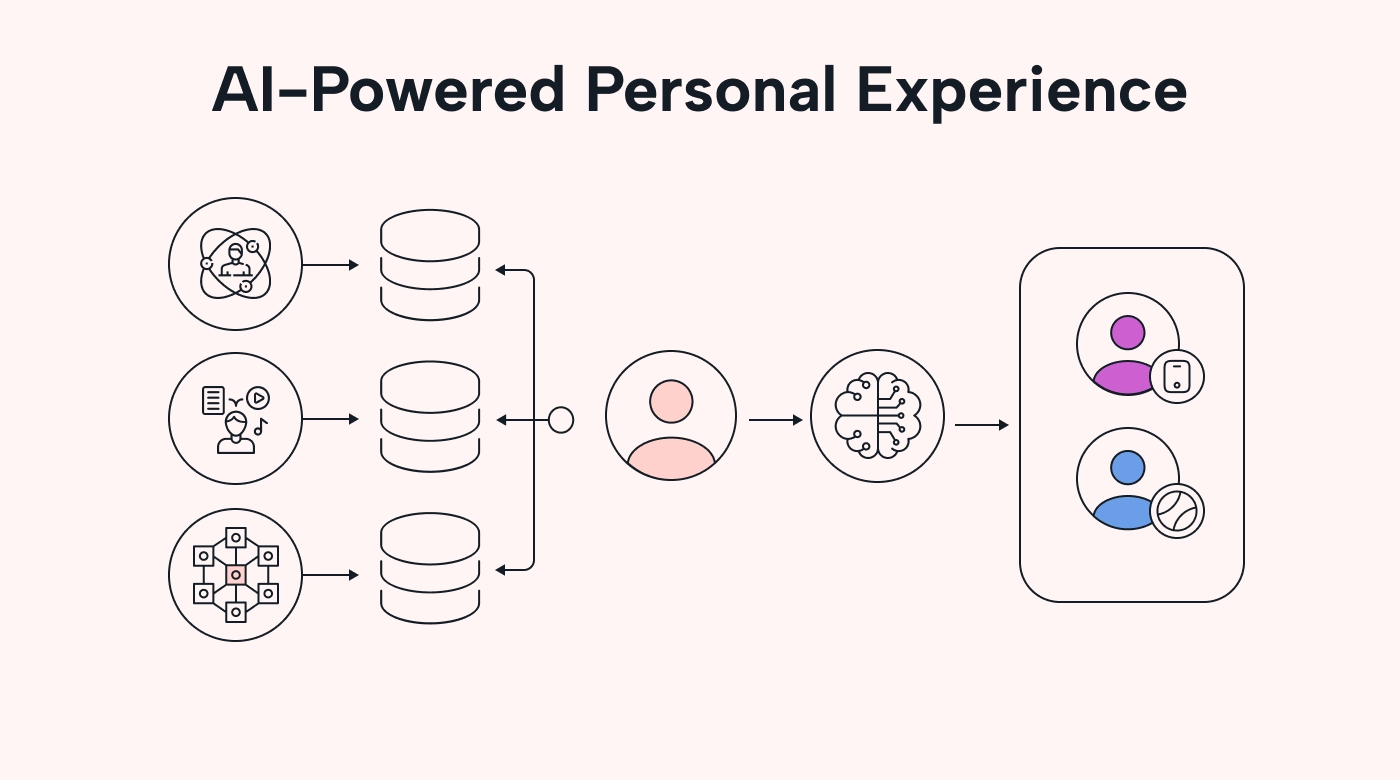 |
In a split second, the AI analyzes users’ previous interactions with your site and tailors the content displayed to their needs.
Here are a few concrete examples of what this can look like in the real world:
- It can show helpful tutorials related to a product they purchased.
- It can recommend refill products for a shampoo they purchased three months ago.
- It can show unique job ads based on the career pages the user visited last time.
These automations create a more personal and streamlined customer experience. And a better experience means higher customer satisfaction and loyalty.
And that’s only on the back end. For acquisition campaigns, this type of AI can help you boost your conversion rates and sales.
Improving customer service
Prescriptive customer support analytics can help you find at-risk customers and intervene proactively.
These algorithms consider a variety of data points, including the following:
- When and how often the customer has sent support inquiries
- The actual words used in customer messages
- Conversation data from speech recognition
- Recent customer reviews on a variety of platforms
- Sentiment analysis of all these customer interactions
- The customer’s usage patterns of your product/service
As a result, the AI generates a realistic image of how your customer feels about your product. You can then prioritize distressed customers, assigning them to your best reps to ensure they get the best possible experience.
A smart support process can help you avoid preventable customer churn due to negative experiences.
Before the advent of AI, plenty of companies were trying to do this. But there’s no reliable way to handle the vast amounts of data manually.
AI tools for business are crucial for companies that want to keep their customers loyal.
Fraud detection
As most transactions today allow credit cards to be used, credit card fraud is a major issue. But AI-powered fraud detection and prevention systems can help. In one case, a new AI-powered system improved detection rates by 300%.
This is just another example of how AI can positively impact business outcomes.
Improving workplace productivity
AI can also play a positive role in boosting your team’s productivity. Instead of relying on self-reporting and scheduling, you can use AI to improve how your team plans and schedules.
An AI productivity tool like Motion, for instance, can help you focus on getting work done, not planning your schedule.
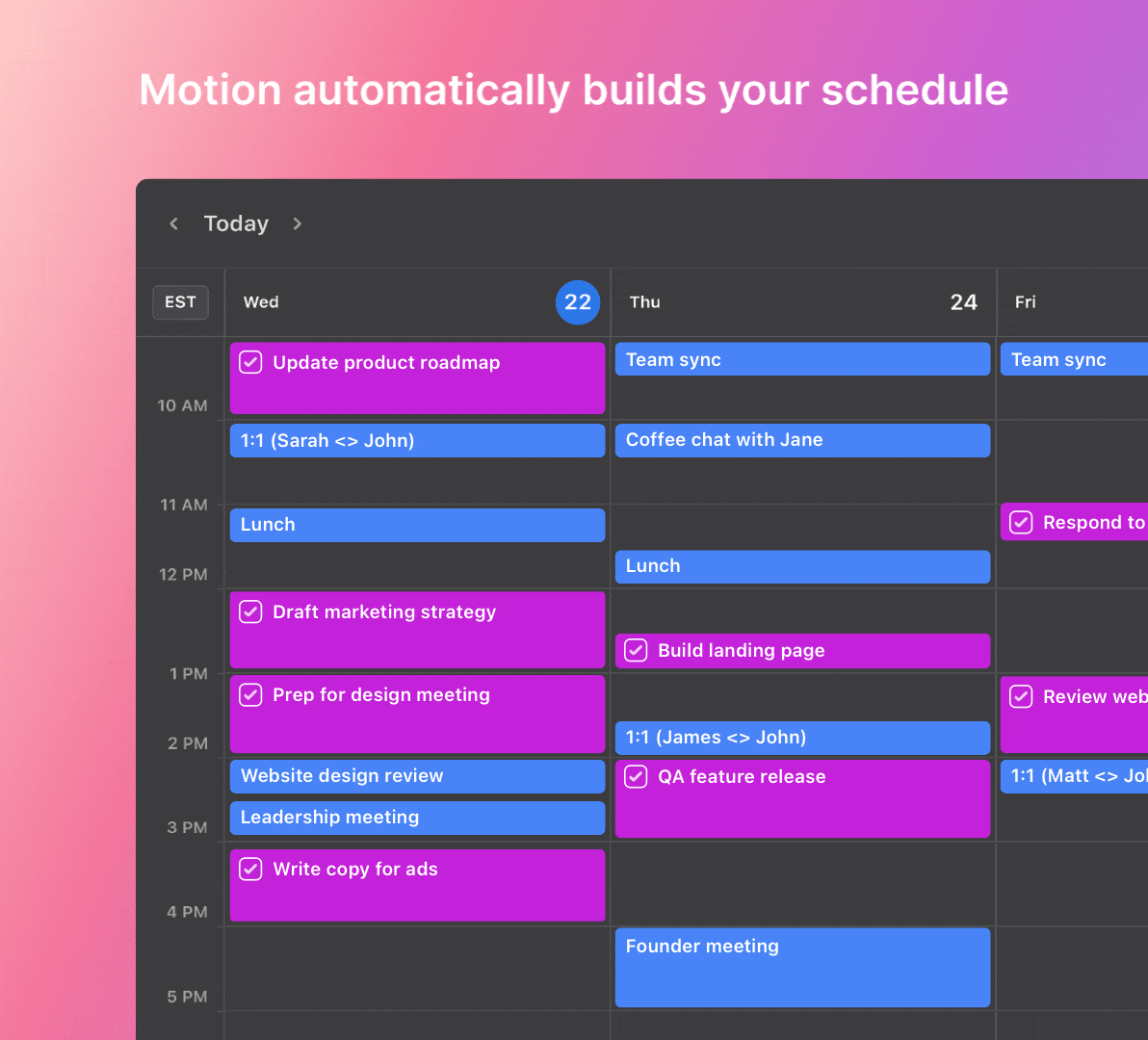 |
Our AI eliminates repetitive tasks, like rearranging your calendar as meetings or emergency tasks come in.
We also help you avoid slow decision-making back-and-forths between members. Plus, if your team needs to have an emergency meeting, Motion will automatically make time for it in everyone’s schedule.
And if you want to dive deep into productivity sinks for your team, we also offer productivity analytics that help you:
- Get a visual overview of all delayed tasks
- See when your team is under or overcommitted with tasks (based on real-time availability)
- Explore tasks finished by employees
Make true data-driven decisions with Motion (or let our AI handle it).
Cost analysis and optimization: financial operations
AI business analytics can help optimize your financial performance. For example, business intelligence platforms like Power BI can analyze your running costs versus sales. This will help you make informed decisions to reduce unnecessary expenses — an easy win for your bottom line.
But business intelligence software can’t provide insights into all areas of your business. At least, it can’t do that “out of the box.”
You could build custom tools with APIs to extend their functionality. But there are also more specialized tools that business users can use to reduce costs.
One example is SaaS operations platforms. They help you cut running SaaS costs by analyzing your SaaS stack for duplicate tools and unused software. The last thing you want is to pay a hefty fee for a SaaS tool you don’t use.
Level up your output with AI-powered productivity analytics
While there are many use cases for AI analytics across most businesses, some are very hard to put in place. You need to merge data from various sources, train new models, and adjust the algorithms. If you want to get there, you probably need to hire your own data scientists.
But we understand that this isn’t an option for every company. Fortunately, when it comes to team productivity, Motion makes it easy to get started.
Our predictive AI model automatically assigns new tasks to employees who have room for them.
 |
The algorithm considers dependencies, previous assignments, deadlines (soft and hard), priorities, and more. Plus, native integrations with Google Calendar and Outlook give these tasks instant visibility to everyone on the team.
Get started with Motion today and streamline your team’s collaboration on crucial business processes.

Ragnar is a Pomodoro enthusiast and a SaaS writer with over 10 years of experience. When he's not focused on getting a sentence just right, he loves cooking and training Muay Thai.
